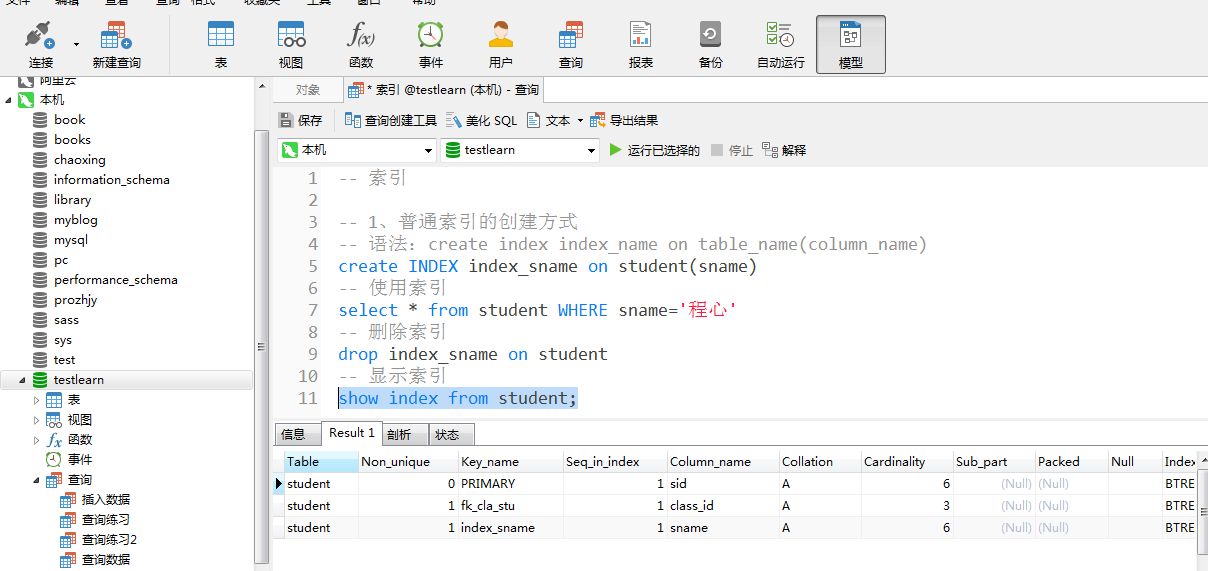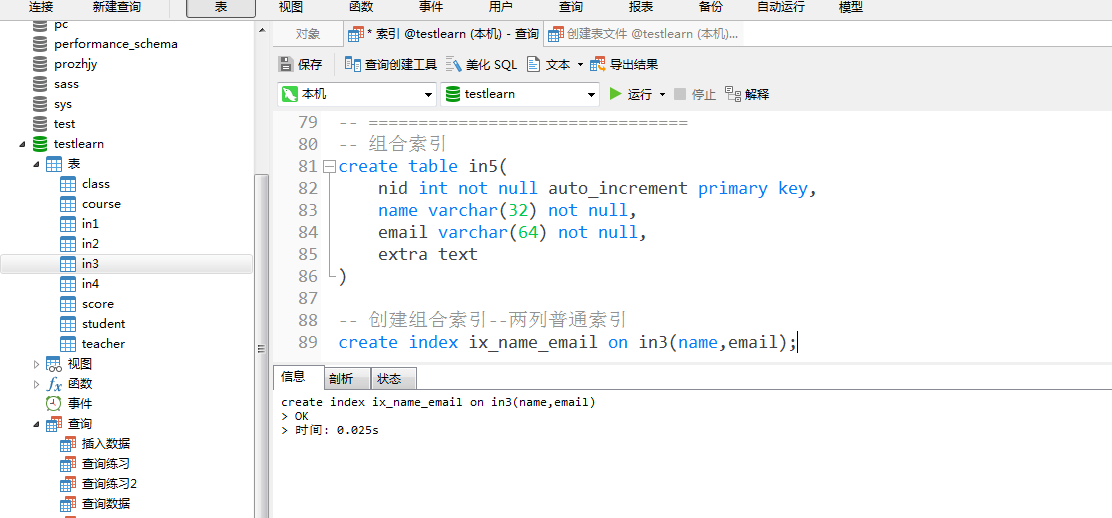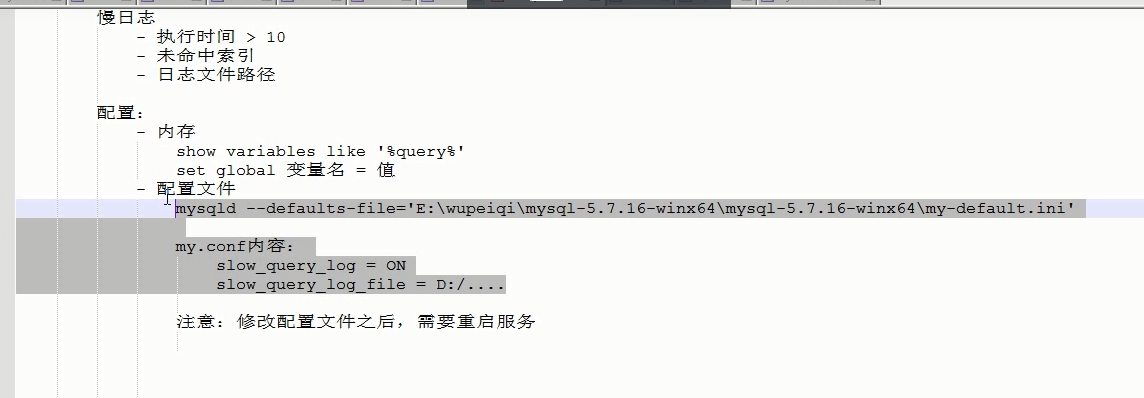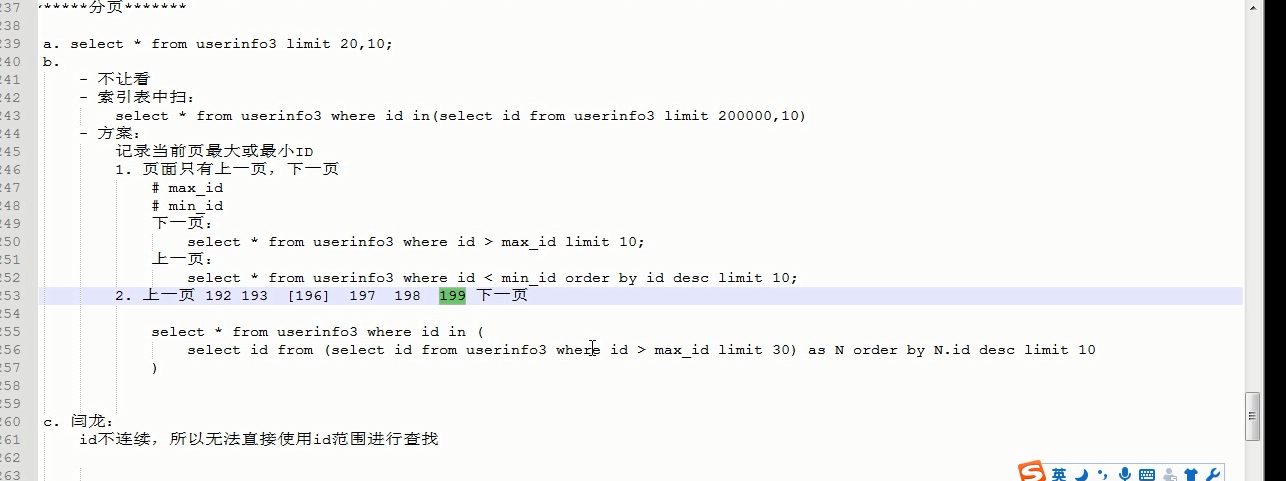MySql索引
MySQL索引
参考文章:https://www.cnblogs.com/wupeiqi/articles/5713323.html
https://www.cnblogs.com/wupeiqi/articles/5716963.html
1、索引
-
补充:
查看表结构命令 desc tableName -
索引,是数据库中专门用于帮助用户快速查询数据的一种数据结构。类似于字典中的目录,查找字典内容时可以根据目录查找到数据的存放位置,然后直接获取即可。
-
Mysql中常见索引有:
- 普通索引
- 唯一索引
- 主键索引
- 组合索引
-
索引原理
-
创建在数据库端的文件,以另一中数据结构进行存储以方便快速查找
-
Hash 值
- 对应的索引生成地址值的Hash值;特点:单值查找的时候特别快,但是查找范围的时候较慢
-
Btrees(B+二叉树) 使用较多

-
1.1 普通索引
- 普通索引只有一个功能,加速查找;
-- 索引
-- 1、普通索引的创建方式
-- 语法:create index index_name on table_name(column_name)
create INDEX index_sname on student(sname)
-- 使用索引
select * from student WHERE sname='程心';
-- 删除索引
drop INDEX index_sname on student;
-- 显示索引
show index from student;
-- 创建表的时候直接创建索引
create table in1(
nid int not null auto_increment primary key,
name varchar(32) not null,
email varchar(64) not null,
extra text, -- 超大的文本
index ix_name (name) -- 指定索引,与创建为唯一索引unique()类似;
)
show INDEX FROM in1;
-- 查看表的结构描述
desc in1;
-- 注意:对于创建索引时如果是BLOB 和 TEXT 类型,必须指定length。
create index ix_extra on in1(extra(32));
-
补充:短索引
-
create index ix_a on student(sname(16)) -- 表示使用sname的前16个字符创建索引 -- 注text 的类型的数据一定要设置字符限制;
-

1.2 唯一索引
功能:加速查询+唯一约束(非空可以根据需求)
-- 唯一索引
create table in2(
nid int not null auto_increment primary key,
name varchar(32) not null,
email varchar(64) not null,
extra text,
unique ix_name (name)-- 创建唯一索引
)
-- 非创建表时候创建唯一索引
-- 语法:create unique index 索引名 on 表名(列名)
DELETE from teacher WHERE tid=11;-- 清楚掉重复数据
CREATE unique index index_tname on teacher(tname);
-- 查看索引
show INDEX FROM teacher;
-- 删除唯一索引
-- DROP UNIQUE INDEX index_tname on teacher
DROP INDEX index_tname on teacher
1.3 主键索引
功能:加速查询+唯一约束+非空约束
-- 主键索引
create table in3(
nid int not null auto_increment primary key,
name varchar(32) not null,
email varchar(64) not null,
extra text,
index ix_name (name)
)
-- =========两种创建表时候创建主键索引的方式================
create table in4(
nid int not null auto_increment,
name varchar(32) not null,
email varchar(64) not null,
extra text,
primary key(nid),
index ix_name (name)
)
-- 不在创建表的时候创建主键
-- 语法:alter table 表名 add primary key(列名);
alter table in4 add PRIMARY KEY(nid)
-- 删除主键索引
show INDEX from in4;
-- 删除主键
alter table in4 drop primary key;
alter table in4 modify nid int, drop primary key;
1.4 组合索引
组合索引是将n个列组合成一个索引
其应用场景为:频繁的同时使用n列来进行查询,如:where n1 = 'alex' and n2 = 666。
-- 组合索引
create table in5(
nid int not null auto_increment primary key,
name varchar(32) not null,
email varchar(64) not null,
extra text
)
-- 创建组合索引--两列普通索引
create index ix_name_email on in3(name,email);
-- 组合索引使用时具备靠左匹配,即单独使用email,或者使用使用where eamil ='' and name='';组合索引不生效;

如上创建组合索引之后,查询:
- name and email -- 使用索引
- name -- 使用索引
- email -- 不使用索引
注意:对于同时搜索n个条件时,组合索引的性能好于多个单一索引合并。
2、其他补充
2.1条件语句
delimiter \\
CREATE PROCEDURE proc_if ()
BEGIN
declare i int default 0;
if i = 1 THEN
SELECT 1;
ELSEIF i = 2 THEN
SELECT 2;
ELSE
SELECT 7;
END IF;
END\\
delimiter ;
if条件语句
2.2 循环语句
delimiter \\
CREATE PROCEDURE proc_while ()
BEGIN
DECLARE num INT ;
SET num = 0 ;
WHILE num < 10 DO
SELECT
num ;
SET num = num + 1 ;
END WHILE ;
END\\
delimiter ;
while循环
delimiter \\
CREATE PROCEDURE proc_repeat ()
BEGIN
DECLARE i INT ;
SET i = 0 ;
repeat
select i;
set i = i + 1;
until i >= 5
end repeat;
END\\
delimiter ;
repeat循环
BEGIN
declare i int default 0;
loop_label: loop
set i=i+1;
if i<8 then
iterate loop_label;
end if;
if i>=10 then
leave loop_label;
end if;
select i;
end loop loop_label;
END
loop
2.3 动态执行sql语句
-
可以用来在数据库端防止SQL注入
delimiter \\ DROP PROCEDURE IF EXISTS proc_sql \\ CREATE PROCEDURE proc_sql () BEGIN declare p1 int; set p1 = 11; set @p1 = p1; PREPARE prod FROM 'select * from tb2 where nid > ?'; EXECUTE prod USING @p1; DEALLOCATE prepare prod; END\\ delimiter ; 动态执行SQL
2.5 其他
- 查看表结构
desc 表名
- 查看生成表的SQL
show create table 表名
- 查看索引
show index from 表名
- 查看执行时间
set profiling = 1;
SQL...
show profiles;
3、正确使用索引
- like '%xx'
select * from tb1 where name like '%cn';
- 使用函数
select * from tb1 where reverse(name) = 'wupeiqi';
- or
select * from tb1 where nid = 1 or email = 'seven@live.com';
特别的:当or条件中有未建立索引的列才失效,以下会走索引
select * from tb1 where nid = 1 or name = 'seven';
select * from tb1 where nid = 1 or email = 'seven@live.com' and name = 'alex'
- 类型不一致
如果列是字符串类型,传入条件是必须用引号引起来,不然...
select * from tb1 where name = 999;
- !=
select * from tb1 where name != 'alex'
特别的:如果是主键,则还是会走索引
select * from tb1 where nid != 123
- >
select * from tb1 where name > 'alex'
特别的:如果是主键或索引是整数类型,则还是会走索引
select * from tb1 where nid > 123
select * from tb1 where num > 123
- order by
select email from tb1 order by name desc;
当根据索引排序时候,选择的映射如果不是索引,则不走索引
特别的:如果对主键排序,则还是走索引:
select * from tb1 order by nid desc;
- 组合索引最左前缀
如果组合索引为:(name,email)
name and email -- 使用索引
name -- 使用索引
email -- 不使用索引
4、注意事项
- 避免使用select *
- count(1)或count(列) 代替 count(*)
- 创建表时尽量时 char 代替 varchar
- 表的字段顺序固定长度的字段优先
- 组合索引代替多个单列索引(经常使用多个条件查询时)
- 尽量使用短索引
- 使用连接(JOIN)来代替子查询(Sub-Queries)
- 连表时注意条件类型需一致
- 索引散列值(重复少)不适合建索引,例:性别不适合
5、执行计划
-- 执行计划
EXPLAIN SELECT * from student;
EXPLAIN SELECT * from student WHERE sid=1;
id
查询顺序标识
如:mysql> explain select * from (select nid,name from tb1 where nid < 10) as B;
+----+-------------+------------+-------+---------------+---------+---------+------+------+-------------+
| id | select_type | table | type | possible_keys | key | key_len | ref | rows | Extra |
+----+-------------+------------+-------+---------------+---------+---------+------+------+-------------+
| 1 | PRIMARY | <derived2> | ALL | NULL | NULL | NULL | NULL | 9 | NULL |
| 2 | DERIVED | tb1 | range | PRIMARY | PRIMARY | 8 | NULL | 9 | Using where |
+----+-------------+------------+-------+---------------+---------+---------+------+------+-------------+
特别的:如果使用union连接气值可能为null
select_type
查询类型
SIMPLE 简单查询
PRIMARY 最外层查询
SUBQUERY 映射为子查询
DERIVED 子查询
UNION 联合
UNION RESULT 使用联合的结果
...
table
正在访问的表名
type
查询时的访问方式,性能:all < index < range < index_merge < ref_or_null < ref < eq_ref < system/const
ALL 全表扫描,对于数据表从头到尾找一遍
select * from tb1;
特别的:如果有limit限制,则找到之后就不在继续向下扫描
select * from tb1 where email = 'seven@live.com'
select * from tb1 where email = 'seven@live.com' limit 1;
虽然上述两个语句都会进行全表扫描,第二句使用了limit,则找到一个后就不再继续扫描。
INDEX 全索引扫描,对索引从头到尾找一遍
select nid from tb1;
RANGE 对索引列进行范围查找
select * from tb1 where name < 'alex';
PS:
between and
in
> >= < <= 操作
注意:!= 和 > 符号
INDEX_MERGE 合并索引,使用多个单列索引搜索
select * from tb1 where name = 'alex' or nid in (11,22,33);
REF 根据索引查找一个或多个值
select * from tb1 where name = 'seven';
EQ_REF 连接时使用primary key 或 unique类型
select tb2.nid,tb1.name from tb2 left join tb1 on tb2.nid = tb1.nid;
CONST 常量
表最多有一个匹配行,因为仅有一行,在这行的列值可被优化器剩余部分认为是常数,const表很快,因为它们只读取一次。
select nid from tb1 where nid = 2 ;
SYSTEM 系统
表仅有一行(=系统表)。这是const联接类型的一个特例。
select * from (select nid from tb1 where nid = 1) as A;
possible_keys
可能使用的索引
key
真实使用的
key_len
MySQL中使用索引字节长度
rows
mysql估计为了找到所需的行而要读取的行数 ------ 只是预估值
extra
该列包含MySQL解决查询的详细信息
“Using index”
此值表示mysql将使用覆盖索引,以避免访问表。不要把覆盖索引和index访问类型弄混了。
“Using where”
这意味着mysql服务器将在存储引擎检索行后再进行过滤,许多where条件里涉及索引中的列,当(并且如果)它读取索引时,就能被存储引擎检验,因此不是所有带where子句的查询都会显示“Using where”。有时“Using where”的出现就是一个暗示:查询可受益于不同的索引。
“Using temporary”
这意味着mysql在对查询结果排序时会使用一个临时表。
“Using filesort”
这意味着mysql会对结果使用一个外部索引排序,而不是按索引次序从表里读取行。mysql有两种文件排序算法,这两种排序方式都可以在内存或者磁盘上完成,explain不会告诉你mysql将使用哪一种文件排序,也不会告诉你排序会在内存里还是磁盘上完成。
“Range checked for each record(index map: N)”
这个意味着没有好用的索引,新的索引将在联接的每一行上重新估算,N是显示在possible_keys列中索引的位图,并且是冗余的。
详细
6、慢日志记录
a、配置MySQL自动记录慢日志
slow_query_log = OFF 是否开启慢日志记录
long_query_time = 2 时间限制,超过此时间,则记录
slow_query_log_file = /usr/slow.log 日志文件
log_queries_not_using_indexes = OFF 为使用索引的搜索是否记录
注:查看当前配置信息:
show variables like '%query%'
修改当前配置:
set global 变量名 = 值

b、查看MySQL慢日志
mysqldumpslow -s at -a /usr/local/var/mysql/MacBook-Pro-3-slow.log
"""
--verbose 版本
--debug 调试
--help 帮助
-v 版本
-d 调试模式
-s ORDER 排序方式
what to sort by (al, at, ar, c, l, r, t), 'at' is default
al: average lock time
ar: average rows sent
at: average query time
c: count
l: lock time
r: rows sent
t: query time
-r 反转顺序,默认文件倒序拍。reverse the sort order (largest last instead of first)
-t NUM 显示前N条just show the top n queries
-a 不要将SQL中数字转换成N,字符串转换成S。don't abstract all numbers to N and strings to 'S'
-n NUM abstract numbers with at least n digits within names
-g PATTERN 正则匹配;grep: only consider stmts that include this string
-h HOSTNAME mysql机器名或者IP;hostname of db server for *-slow.log filename (can be wildcard),
default is '*', i.e. match all
-i NAME name of server instance (if using mysql.server startup script)
-l 总时间中不减去锁定时间;don't subtract lock time from total time
"""
7、Limit分页
无论是否有索引,limit分页是一个值得关注的问题
每页显示10条:
当前 118 120, 125
倒序:
大 小
980 970 7 6 6 5 54 43 32
21 19 98
下一页:
select
*
from
tb1
where
nid < (select nid from (select nid from tb1 where nid < 当前页最小值 order by nid desc limit 每页数据 *【页码-当前页】) A order by A.nid asc limit 1)
order by
nid desc
limit 10;
select
*
from
tb1
where
nid < (select nid from (select nid from tb1 where nid < 970 order by nid desc limit 40) A order by A.nid asc limit 1)
order by
nid desc
limit 10;
上一页:
select
*
from
tb1
where
nid < (select nid from (select nid from tb1 where nid > 当前页最大值 order by nid asc limit 每页数据 *【当前页-页码】) A order by A.nid asc limit 1)
order by
nid desc
limit 10;
select
*
from
tb1
where
nid < (select nid from (select nid from tb1 where nid > 980 order by nid asc limit 20) A order by A.nid desc limit 1)
order by
nid desc
limit 10;





 浙公网安备 33010602011771号
浙公网安备 33010602011771号